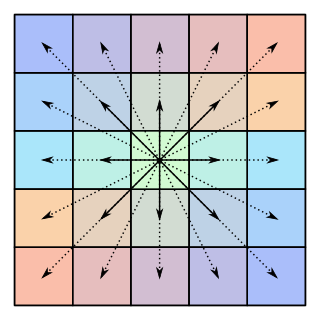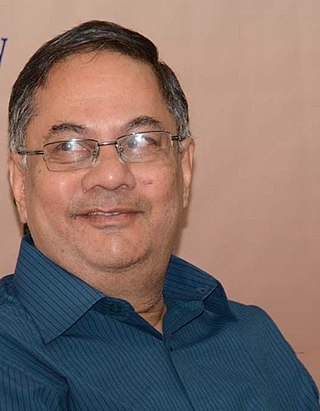In mathematics, a Hermitian matrix is a complex square matrix that is equal to its own conjugate transpose—that is, the element in the i-th row and j-th column is equal to the complex conjugate of the element in the j-th row and i-th column, for all indices i and j:
In graph theory and computer science, an adjacency matrix is a square matrix used to represent a finite graph. The elements of the matrix indicate whether pairs of vertices are adjacent or not in the graph.
In linear algebra, a tridiagonal matrix is a band matrix that has nonzero elements only on the main diagonal, the subdiagonal/lower diagonal, and the supradiagonal/upper diagonal. For example, the following matrix is tridiagonal:
In matrix theory, the Perron–Frobenius theorem, proved by Oskar Perron and Georg Frobenius, asserts that a real square matrix with positive entries has a unique eigenvalue of largest magnitude and that eigenvalue is real. The corresponding eigenvector can be chosen to have strictly positive components, and also asserts a similar statement for certain classes of nonnegative matrices. This theorem has important applications to probability theory ; to the theory of dynamical systems ; to economics ; to demography ; to social networks ; to Internet search engines (PageRank); and even to ranking of American football teams. The first to discuss the ordering of players within tournaments using Perron–Frobenius eigenvectors is Edmund Landau.
In mathematics, a nonnegative matrix, written

In mathematics, especially in linear algebra and matrix theory, a centrosymmetric matrix is a matrix which is symmetric about its center.
Lloyd Nicholas Trefethen is an American mathematician, professor of numerical analysis and head of the Numerical Analysis Group at the Mathematical Institute, University of Oxford.
In mathematics, a P-matrix is a complex square matrix with every principal minor is positive. A closely related class is that of -matrices, which are the closure of the class of P-matrices, with every principal minor 0.
In mathematics, especially linear algebra, an M-matrix is a matrix whose off-diagonal entries are less than or equal to zero and whose eigenvalues have nonnegative real parts. The set of non-singular M-matrices are a subset of the class of P-matrices, and also of the class of inverse-positive matrices. The name M-matrix was seemingly originally chosen by Alexander Ostrowski in reference to Hermann Minkowski, who proved that if a Z-matrix has all of its row sums positive, then the determinant of that matrix is positive.
In the mathematical field of linear algebra and convex analysis, the numerical range or field of values of a complex matrix A is the set
In mathematics, the Lie product formula, named for Sophus Lie (1875), but also widely called the Trotter product formula, named after Hale Trotter, states that for arbitrary m × m real or complex matrices A and B, where eA denotes the matrix exponential of A. The Lie–Trotter product formula and the Trotter–Kato theorem extend this to certain unbounded linear operators A and B.

In mathematics, a matrix is a rectangular array or table of numbers, symbols, or expressions, with elements or entries arranged in rows and columns, which is used to represent a mathematical object or property of such an object.

Charles Royal Johnson is an American mathematician specializing in linear algebra. He is a Class of 1961 professor of mathematics at College of William and Mary. The books Matrix Analysis and Topics in Matrix Analysis, co-written by him with Roger Horn, are standard texts in advanced linear algebra.
Leonid Mirsky was a Russian-British mathematician who worked in number theory, linear algebra, and combinatorics. Mirsky's theorem is named after him.
Adi Ben-Israel is a mathematician and an engineer, working in applied mathematics, optimization, statistics, operations research and other areas. He is a Professor of Operations Research at Rutgers University, New Jersey.

Ravindra B. Bapat is an Indian mathematician known for the Bapat–Beg theorem.

Robert James Plemmons is an American mathematician specializing in computational mathematics. He is the emeritus Z. Smith Reynolds Professor of Mathematics and Computer Science at Wake Forest University. In 1979, Plemmons co-authored the book Nonnegative Matrices in the Mathematical Sciences.
Shmuel Friedland is an Israeli-American mathematician.
Beresford Neill Parlett is an English applied mathematician, specializing in numerical analysis and scientific computation.
Henryk Minc was a Polish-born, British-educated, American professor of mathematics. He is known for his 1963 conjecture of what is now called the Bregman–Minc inequality, proved in 1973 by Lev M. Bregman.






